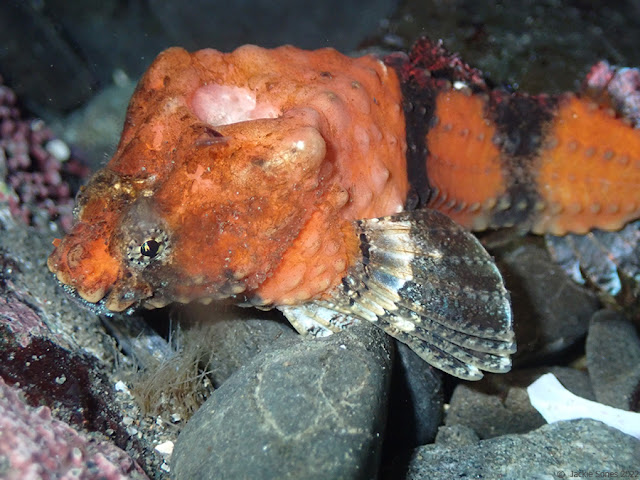
One of the most impressive features of many animals in the intertidal zone is the way their color patterns match their surroundings. It makes it challenging for visual predators to spot them. And it also requires an observer to slow down and let their eyes and mind adjust to the setting in the tidepool. (Maybe we need a new phrase ="slow tidepooling"?)
We thought it would be fun to show some examples. Above is a chiton (perhaps Lepidozona radians) — note there are eight plates, but the middle four plates are orange, the front two plates near (head end) are flecked with brown and green, and the back two plates (tail end) are mottled. These varied colors make it hard to identify this as a chiton at first.
Below is a small sculpin. Check out the way the pink stripe running across its body matches the coralline algae patches on the rock. And the other colors look like the surrounding rocks (grays and greens) and encrusting algae (deep maroon). It also helps that sculpins often stay very still — the lack of movement makes it less likely that they'll catch your eye:
The camouflage abilities of octopus are well known — they can settle on a new substrate and blend in within seconds by adjusting pigment cells (chromatophores) in their skin. Here's one looking a lot like a rock — but also note how well the arms/tentacles on either side of the body have a different color and pattern than the main portion of the body. It's hard to make them out! (If you look closely sometimes you can spot the suckers on the underside of the tentacles.)
And here's one more — an intriguing shrimp called a Deep-blade Shrimp (Spirontocaris prionota). (Hint: Look for the shrimp's eyes in the center of the photo.) Not only do the colors of the shrimp match the coralline algae, but the shrimp also has small hairs (setae) that accumulate bits of debris that help it look "messy", making it less clear that this is a shrimp.
It takes some special attention to spot animals like this when they're so well camouflaged, but it's worth the extra time! ADDENDUM (31 December 2022) — P.S. To make it easier to find the octopus, here's an edited photo showing the outline and main features:








































